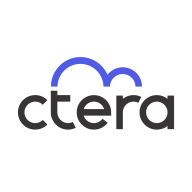

CTERA Enterprise File Services Platform and Rivery compete in the enterprise cloud space, focusing on data management and analytics optimization. While CTERA is noted for its pricing and support, Rivery's feature richness makes it a preferable choice for those seeking extensive functionality that justifies its cost.
Features: CTERA provides robust file sharing and synchronization, secure data storage, and comprehensive data protection. Rivery excels in powerful data integration capabilities, flexible pipeline automation, and real-time analytics. The main difference is CTERA's focus on secure file services, whereas Rivery emphasizes data processing and analytics capability.
Ease of Deployment and Customer Service: CTERA offers straightforward deployment and is known for strong customer service with quick response times. Rivery's deployment process is flexible and adaptable to various data environments, with comprehensive support included. The difference is CTERA's emphasis on secure centralized deployment and Rivery's customizable integration processes.
Pricing and ROI: CTERA is recognized for competitive setup costs and ROI that attracts cost-conscious buyers. Meanwhile, Rivery, with higher initial setup costs, offers substantial ROI through advanced data integration capabilities. The primary contrast is CTERA's cost-effectiveness versus Rivery's value-driven pricing model aligned with feature-intensive offerings.

The CTERA Enterprise File Services Platform provides a cloud-native global file system over public and private object storage, revolutionizing the world of hybrid cloud data solutions. Enhanced by a rich data services ecosystem, CTERA enables enterprises to gain full control of their data for optimal edge performance, data insight, and governance. The platform focuses on security, providing features like data encryption, access controls, and ransomware protection. Centralized management tools enable efficient data control and monitoring. The platform is being used to replace legacy NAS and file servers, especially at remote locations, and simplify backup and disaster recovery of file data while providing the flexibility of multi-cloud deployments with infinite scalability. CTERA is at the core of hybrid cloud transformations of some of the world’s largest banks, healthcare organizations, global media groups, and government agencies, in deployments that scale to tens of petabytes.
Rivery is a serverless, SaaS DataOps platform that empowers companies of all sizes around the world to consolidate, orchestrate, and manage internal and external data sources with ease and efficiency.
By offering comprehensive data solutions and partnering with complementary technology providers, including Google, Snowflake, Tableau, and Looker, Rivery enables data-driven companies to build the perfect ecosystems for all their data processes.
We monitor all Cloud Migration reviews to prevent fraudulent reviews and keep review quality high. We do not post reviews by company employees or direct competitors. We validate each review for authenticity via cross-reference with LinkedIn, and personal follow-up with the reviewer when necessary.